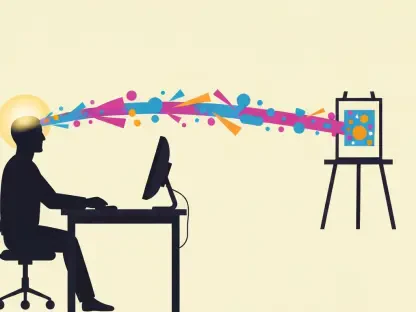Setting the Stage for AI in Law
The legal profession stands at a pivotal moment where technology is no longer just an accessory but a transformative force that reshapes the industry. Consider the staggering volume of data lawyers must navigate—millions of documents in a single case, each requiring meticulous review, making the workload overwhelming without modern solutions. Artificial intelligence (AI) has emerged as a game-changer, promising to streamline these daunting tasks and redefine how legal work is conducted. This review delves into the capabilities of AI within the legal sector, exploring how it enhances efficiency while posing unique challenges that demand careful consideration.
The integration of AI into law is part of a broader digital shift across industries, where automation and data-driven insights are becoming indispensable. Law firms and legal tech companies are increasingly adopting these tools to stay competitive, driven by the need to manage complex caseloads with greater precision. This analysis aims to unpack the core features of AI in legal practice, assess its real-world impact, and evaluate its potential to reshape the field.
Core Features and Performance of AI in Legal Work
Automating the Mundane for Greater Efficiency
One of the standout capabilities of AI in the legal domain is its ability to automate repetitive tasks that often consume significant time. Document review, legal research, and case file analysis—processes that once required hours of manual effort—can now be handled by algorithms with remarkable speed. This automation allows lawyers to shift their focus from routine work to strategic planning and client advocacy, fundamentally enhancing productivity.
Beyond time savings, AI tools demonstrate impressive accuracy in identifying relevant information within vast datasets. For instance, during discovery phases, these systems can flag critical clauses or inconsistencies in contracts that might otherwise be overlooked. However, the technology is not without flaws, as it sometimes struggles with context-specific nuances that require human interpretation, underscoring the need for oversight.
The significance of this automation lies in its potential to democratize legal services. By reducing the labor-intensive aspects of law, firms can handle more cases or offer services at lower costs, potentially broadening access to justice. Yet, the reliance on such systems also raises questions about data quality and the risk of errors propagating through automated processes.
Predictive Analytics as a Strategic Tool
AI’s capacity to provide predictive analytics marks another critical advancement for legal professionals. By analyzing historical data and recognizing patterns, these tools can forecast potential outcomes of cases, aiding in strategy formulation. Whether assessing the likelihood of a settlement or predicting judicial rulings, AI offers decision-support insights that were previously unattainable at scale.
Technically, these systems leverage machine learning to refine their predictions over time, drawing from vast repositories of case law and legal precedents. In practice, this means a lawyer preparing for litigation might receive data-driven guidance on the strengths and weaknesses of their arguments. Still, the technology falls short in accounting for unpredictable human factors, such as a judge’s personal inclinations or jury dynamics, which often play a decisive role.
While predictive tools are powerful, their performance hinges on the quality and diversity of data inputs. Incomplete or biased datasets can skew results, leading to misguided strategies. This limitation highlights that AI serves best as an advisory mechanism rather than a definitive arbiter, requiring lawyers to apply their judgment to contextualize the insights provided.
Recent Innovations and Adoption Trends
The landscape of AI for legal applications continues to evolve with cutting-edge developments in natural language processing and machine learning. These technologies enable systems to better understand legal texts, extracting meaning from complex jargon with increasing precision. Such advancements are driving tools that can draft preliminary contracts or summarize lengthy filings, tasks that were once exclusively human domains.
Adoption rates among law firms are climbing, with many integrating AI into their workflows to gain a competitive edge. Over the next few years, from 2025 onward, expectations point to even wider acceptance as smaller practices recognize the cost-effectiveness of these solutions. Additionally, attitudes among legal professionals are shifting, with growing openness to technology as a means of enhancing rather than threatening their roles.
Emerging trends also include the customization of AI tools for niche legal areas, such as intellectual property or regulatory compliance. Legal tech startups are at the forefront, tailoring solutions to meet specific industry needs. This rapid innovation cycle suggests that the capabilities of AI in law will only expand, though it also necessitates continuous updates to ensure relevance and accuracy.
Real-World Impact Across Legal Sectors
AI’s practical applications span diverse areas of law, demonstrating tangible benefits in corporate litigation, intellectual property disputes, and criminal defense. In corporate settings, AI-driven contract analysis tools are streamlining due diligence by quickly identifying risks in agreements, saving countless hours during mergers or acquisitions. Leading firms have reported significant reductions in review times, allowing them to allocate resources more effectively.
In the realm of e-discovery, AI is proving indispensable by sifting through terabytes of digital evidence to pinpoint relevant materials. This capability is particularly valuable in high-stakes cases where speed and precision are paramount. Notable implementations by major legal tech providers showcase how these tools can handle multilingual documents or detect subtle patterns, offering a clear edge in complex litigation.
Unique use cases also emerge in public defense, where AI assists overworked attorneys by prioritizing case elements based on urgency or likelihood of success. Such applications highlight the technology’s potential to level the playing field, especially for under-resourced sectors. However, the uneven access to advanced tools across different practice areas remains a barrier to uniform impact.
Challenges Hindering Broader Implementation
Despite its promise, AI in legal practice faces substantial hurdles, starting with technical limitations. Algorithms often struggle with the interpretive depth required for ambiguous legal texts, leading to outputs that may lack the necessary finesse. Moreover, the risk of bias embedded in training data poses a persistent threat, potentially perpetuating inequities if not rigorously addressed.
Ethical and regulatory concerns further complicate adoption, as issues of data privacy and accountability come to the forefront. Ensuring client confidentiality while using cloud-based AI systems is a pressing challenge, with breaches carrying severe reputational and legal consequences. Regulatory frameworks are still catching up, creating uncertainty about compliance and liability in AI-driven decisions.
Market barriers also impede progress, as high initial costs and the need for specialized training deter smaller firms from investing. Resistance to change among traditional practitioners adds another layer of difficulty, slowing the pace of integration. Ongoing efforts to refine AI tools focus on aligning them with legal ethics and building trust, but these challenges suggest a cautious path forward.
Looking Ahead: The Trajectory of AI in Law
The future of AI in the legal profession holds immense potential, with anticipated breakthroughs likely to enhance tool sophistication. Innovations in contextual understanding could enable systems to better grasp the subtleties of legal arguments, narrowing the gap between machine and human reasoning. Such advancements may also influence legal education, prompting curricula to emphasize tech literacy alongside traditional skills.
Long-term implications point to a redefined professional landscape where AI handles an even broader array of tasks, from drafting pleadings to mediating disputes. Yet, the enduring necessity for human ethical reasoning ensures that lawyers remain central to the justice system. Balancing technological efficiency with moral judgment will be key to shaping a sustainable future for the field.
Final Verdict on AI’s Role in Legal Practice
Reflecting on this comprehensive evaluation, AI proves to be a powerful ally in transforming legal workflows, delivering efficiency and strategic insights that were previously unattainable. Its performance in automating routine tasks and supporting decision-making stands out as a significant boon for productivity across various legal sectors. However, the technology stumbles when faced with nuanced interpretation and ethical dilemmas, revealing clear boundaries to its capabilities.
The challenges of bias, privacy, and market access underscore the need for deliberate steps to refine and regulate these tools. Moving forward, stakeholders should prioritize developing transparent AI systems and fostering accessible training programs to ensure equitable benefits. Investing in robust ethical guidelines emerges as a critical next step to safeguard client trust and uphold justice.
Ultimately, the journey of integrating AI into law highlights a path of collaboration rather than replacement. Legal professionals are encouraged to embrace technology as a means to amplify their unique human strengths, such as empathy and moral discernment. The focus for the future rests on forging partnerships between innovation and tradition, ensuring that AI serves as a catalyst for advancing the rule of law while preserving the irreplaceable human essence of legal advocacy.









